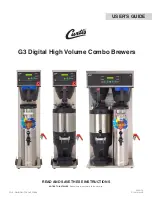
d
e
f
g
h
©
Street
Crane
Co
Ltd
Ref:
D3256
rev.
B
Page
77
of
103
6
FAULT
FINDING
1
When
fault
finding
on
live
electrical
circuits
or
energised
equipment
wear
the
relevant
PPE
and
use
test
equipment
suitably
rated
for
the
tests
being
carried
out.
Obtain
information
from
the
people
who
use
the
equipment
and
who
were
present
at
the
time
the
fault
developed.
Observe
the
system
during
start
‐
up,
operation
and
shut
‐
down
to
trace
the
fault
area.
Isolate
the
area
of
the
system
that
is
suspicious
but
do
not
restrict
your
focus
too
narrowly.
Test
and
take
corrective
action
as
required.
Check
the
system
/
device
is
working
properly
and
document
your
findings
and
corrective
measures.
Should
you
require
any
assistance
from
the
Street
Crane
Service
Department
please
have
available
the
following
information:
‐
The
hoist
serial
number
and
details
from
both
hoist
nameplates.
The
reading
on
the
hours
‐
in
‐
service
meter.
A
description
and
the
nature
and
extent
of
the
fault.
Explain
under
what
circumstances
the
fault
occurred.
State
your
suspected
cause.
6.1
GENERAL
Problem
Possible
Cause
Remedy
Hoist
will
not
operate
but
travel
moves
in
wrong
direction.
Wrong
phase
sequence
to
hoist
or
voltage
supply
to
hoist
is
too
low.
Correct
phase
sequence
and
supply.
Hoist
unit
does
not
operate
or
will
not
start
.
No
electrical
power
supply
or
not
all
phases
are
present.
Check
that
the
power
supply
is
correct
and
the
equipment
is
switched
ON.
Phase
monitoring
relay
not
set
correctly.
Check
settings
on
relay
as
section
3.16.3.
Emergency
stop
activated.
Release
emergency
stop.
First
ensure
that
the
emergency
stop
button
has
not
been
depressed
because
of
a
fault.
Pendant
or
switchgear
fault.
Check
condition
of
pushbuttons,
pendant
wiring
and
switchgear.
After
a
long
period
out
of
service,
the
brake(s)
may
be
stuck.
Dismantle
and
service
the
brake.
Movement
of
the
equipment
does
not
correspond
to
the
symbols
on
the
controller.
Power
supply
wrongly
connected.
Check
the
phase
connections
to
the
equipment
and
to
the
relevant
motor.
Hoist
will
not
raise.
Hook
is
at
upper
limit
switch
position.
Lower
to
reset
the
limit.
Check
setting
of
limit.
Attempt
to
lift
load
in
excess
of
hoist
rated
capacity.
Lower
load
to
floor.
Do
not
apply
any
load
greater
than
rated
capacity
of
hoist.
Motor
over
‐
temperature
protection
tripped.
Allow
motor
to
cool.
See
fault
finding
guide
for
motors.
Hoist
will
not
lower.
Hook
is
already
at
lower
limit
switch
position.
Raise
bottom
block
to
reset
limit.
Check
setting
of
limit
SWL
cannot
be
lifted
or
loads
in
excess
of
SWL
can
be
lifted.
Rated
capacity
limiter
incorrectly
set.
Check
and
adjust
setting
of
rated
capacity
limiter.
Hoist
does
not
travel
when
no
load
attached.
Wear
on
the
wheel
and/or
reaction
roller.
Check
and
adjust
the
setting
of
the
reaction
roller
spring.
Bottom
hook
block
and
rope
rotate.
Twist
in
the
rope.
Remove
the
wire
rope
and
let
it
hang
or
lay
freely
to
remove
the
twist.
Содержание ZX6
Страница 2: ......
Страница 4: ...defgh Street Crane Co Ltd IV THIS PAGE IS INTENTIONALLY BLANK ...
Страница 99: ...defgh Street Crane Co Ltd Ref D3256 rev B Page 99 of 103 NOTES ...
Страница 100: ...defgh Street Crane Co Ltd Page 100 of 103 Ref D3256 rev B NOTES ...
Страница 101: ......
Страница 102: ......
















































